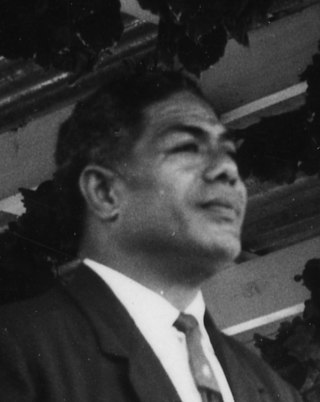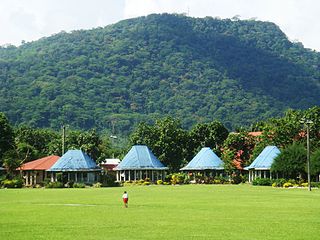
Samoa,officially the Independent State of Samoa and until 1997 known as Western Samoa,is a Polynesian island country consisting of two main islands;two smaller,inhabited islands;and several smaller,uninhabited islands,including the Aleipata Islands. Samoa is located 64 km (40 mi) west of American Samoa,889 km (552 mi) northeast of Tonga,1,152 km (716 mi) northeast of Fiji,483 km (300 mi) east of Wallis and Futuna,1,151 km (715 mi) southeast of Tuvalu,519 km (322 mi) south of Tokelau,4,190 km (2,600 mi) southwest of Hawaii,and 610 km (380 mi) northwest of Niue. The capital and largest city is Apia. The Lapita people discovered and settled the Samoan Islands around 3,500 years ago. They developed a Samoan language and Samoan cultural identity.

Politics of Samoa takes place in a framework of a parliamentary representative democratic state whereby the Prime Minister of Samoa is the head of government. Existing alongside the country's Western-styled political system is the faʻamatai chiefly system of socio-political governance and organisation,central to understanding Samoa's political system.

Malietoa Tanumafili II was a Samoan paramount chief who was O le Ao o le Malo of Samoa from its independence in 1962 until his death in 2007. He was appointed to the high title of Malietoa in 1940.

FiamēMataʻafa Faumuina Mulinuʻu II was a Western Samoan paramount chief and politician. The holder of the Mataʻafa title,one of the four main Samoan chieftainships,he became the first prime minister of Western Samoa in 1959,serving until 1970. He held the position again from 1973 until his death in 1975.

Tui Ātua Tupua Tamasese Tupuola Tufuga Efi is a Samoan political leader and paramount chief,as holder of the maximal lineage Tupua Tamasese title. He also holds the royal pāpā title of Tui Ātua.

Tupua Tamasese,formally known as Tupua,is a state dynasty and one of the four paramount chiefly titles of Samoa,known as the tama a ʻāiga. It is the titular head of one of Samoa's two great royal families –SāTupua,the lineage of Queen Salamasina. The current holder of the title is Tui Ātua Tupua Tamasese Efi.

Susuga Malietoa Tanumafili I was the Malietoa in Samoa from 1898 until his death in 1939. After the death of his father,Malietoa Laupepa,the recognized King of Samoa by many western countries,Tanumafili was immediately crowned as King,alongside Tupua Tamasese Lealofi I as vice-king. Tanumafili was backed by the United States and United Kingdom,however Germany supported rebel chief Mata'afa Iosefo who was eyeing the throne. The battle between the two made up the Second Samoan Civil War and in the end caused the Tripartite Convention that split the islands. After the war,Malietoa pursued education in Fiji and then came back to Samoa,where he was appointed as an advisor.

Falefā is located on the north eastern coast of Upolu island in Samoa. It was the ancient capital during the ‘Malo’ (‘government’) of Tupu Tafa'ifa (King) Fonoti. After having defeated his nephew Toleafoa and sister Samalaulu for control of Samoa King Fonoti chose to rule from his new seat in Falefa,an honour remembered in its faalupega to this day.

Faʻamatai is the indigenous political ('chiefly') system of Samoa,central to the organization of Samoan society. It is the traditional indigenous form of governance in both Samoas,comprising American Samoa and the Independent State of Samoa. The term comprises the prefix faʻa and the word matai.

Mata'afa Iosefo was a Paramount Chief of Samoa who was one of the three rival candidates for the kingship of Samoa during colonialism. He was also referred to as Tupua Malietoa To'oa Mata'afa Iosefo. He was crowned the King of Samoa on 15 November 1898.

Mata'afa Faumuina Fiame Mulinu'u I was a high chief of Samoa and a leader of the country's pro-independence Mau movement during the 1920's and 1930's. He was the holder of high-ranking ali'i chiefly titles:the Tama-a-'aiga Mata'afa,Fiame from Lotofaga and Faumuina from Lepea.

Matāʻafa is one of the four paramount tama a ʻāiga titles of Samoa. It is one of two such titles originating from the Atua district at the east end of Upolu island and has its historical seat in the village of Amaile. Prominent holders of the title include Matāʻafa Iosefo of Falefa,one of the three rival candidates for the kingship of Samoa during the early colonial period,Mataʻafa Faumuina Fiame Mulinuʻu I of Lepea and Lotofaga,who became leader of Samoa's pro-independence Mau movement after Tupua Tamasese Lealofi III's assassination;and his son FiamēMataʻafa Faumuina Mulinuʻu II (1921–1975),the first Prime Minister of Samoa.

Lepea is a village on the island of Upolu in Samoa. The picturesque settlement of round Samoan houses built in a concentric pattern in large open grounds (malae) is situated 5 minutes drive west of the capital Apia on the north central coast of the island. It is part of the Tuamasaga electoral district.

Tuimalealiʻifano is one of the four paramount chiefly titles of Samoa,known as the tama a ʻāiga. Samoa's other three paramount chiefs are Malietoa,Mataʻafa and Tupua Tamasese. The seat of the Tuimalealiʻifano title is at Falelatai in the Aʻana district.

Tui Ātua Tupua Tamasese Lealofi IV was the second prime minister of Samoa from 25 February 1970 to 20 March 1973 and again from 21 May 1975 to 24 March 1976. He held the title of Tupua Tamasese,one of the four main chiefly titles of Samoa from 1965 until his death in 1983.

Afioga Tuimalealiʻifano Vaʻaletoʻa Eti Sualauvi II is a Samoan politician who is the current O le Ao o le Malo of Samoa,in office since 2017.
Tuiaana Tuimalealiʻifano Suatipatipa II was a Western Samoan paramount chief,politician and church elder. For most of the period between 1962 and 1974 he was the only member of the Council of Deputies,whose members serve as deputy to the O le Ao o le Malo.

Tuimaleali'ifano Fa'aoloi'i Si'ua'ana I was a Samoan paramount chief,and the first holder of the Tuimaleali'ifano title. He was one of the leaders of the Mau movement.
Tamaʻāiga is a Samoan term used to refer to the four high chiefly titles in the faʻamatai system –specifically,the Malietoa,Mataʻafa,Tupua Tamasese and Tuimalealiʻifano.
Tafaʻifa is a historical Samoan title. It was the highest title of the Samoan aristocracy from the 16th to the 19th century.
















